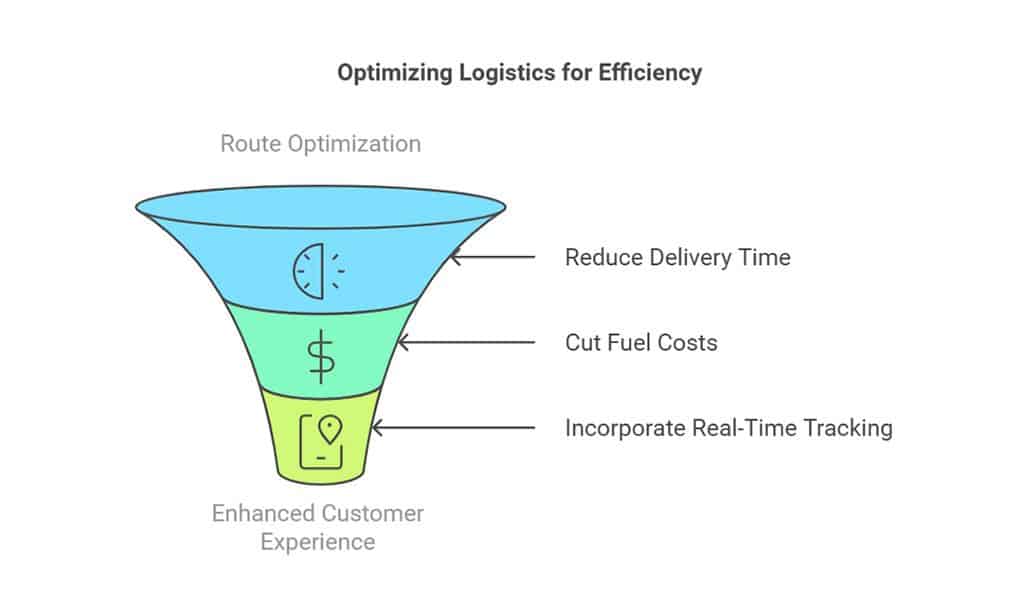In today’s fast-paced and competitive market, small businesses in Austria must stay ahead by adopting innovative strategies to streamline operations, improve decision-making, and optimize resources. One such transformative tool is business mapping.
This technique combines data visualization, analytics, and strategic planning to create actionable insights tailored to your business needs.
Whether you’re managing logistics, enhancing customer targeting, or planning for future growth, business mapping can redefine how you operate.
This article will explore 10 powerful ways business mapping for small business in Austria while optimizing your business strategies for greater success.
What Is Business Mapping and Why Does It Matter?
Business mapping is a systematic approach that uses visual tools to represent workflows, processes, and geographical data.
By visualizing operations, businesses can identify inefficiencies, track performance, and uncover new opportunities.
It provides a clear roadmap to achieve goals by aligning operational strategies with measurable outcomes.
Key components of business mapping include:
- Workflow diagrams: To streamline operational processes and visualize task progress.
- Geographical maps: For customer segmentation, logistics planning, and territory analysis.
- Data analytics tools: To integrate real-time data into actionable business strategies.
Benefits of Business Mapping for Small Businesses
For small businesses in Austria, where resources and budgets may be limited, business mapping offers several advantages:
- Efficiency: Eliminates bottlenecks in workflows and optimizes resources.
- Customer Insights: Enhances marketing strategies by targeting the right audience.
- Growth Planning: Provides actionable insights for expansion.
- Risk Mitigation: Identifies vulnerabilities and creates contingency plans.
The Austrian Market Landscape: Why Business Mapping Is Crucial
Operating a small business in Austria comes with its own set of challenges:
- Diverse demographics: Austria’s urban and rural areas have distinct consumer behaviors, requiring localized strategies.
- Regulations: Navigating strict EU compliance standards for operations and data privacy.
- Geographical constraints: Managing logistics in alpine regions can add complexity to delivery and supply chain processes.
Leveraging Business Mapping to Address Market Challenges
Business mapping helps small businesses adapt by offering tailored solutions. For example:
- Identify underserved areas: Pinpoint potential markets for expansion or new offerings.
- Optimize supply chains: Overcome logistical barriers with route planning.
- Hyper-local campaigns: Customize marketing efforts to match local preferences and behaviors.
10 Ways Business Mapping for Small Business In Austria
1. Enhanced Workflow Efficiency
Mapping workflows allows businesses to pinpoint inefficiencies, reducing delays and improving productivity. By visualizing steps in a process, small businesses can identify unnecessary tasks and optimize time and resources.
Example: A small bakery in Vienna optimized production schedules using workflow mapping, reducing preparation time by 20%.
| Tool | Purpose | Best For |
| Lucidchart | Creating detailed diagrams | Workflow visualization |
| Visio | Workflow and process mapping | Task allocation |
Key Takeaway: Regularly update workflows to adapt to changes in demand or market trends.
2. Improved Resource Allocation
Business mapping aids in allocating resources—such as staff, equipment, and materials—to areas where they’re most needed. This ensures optimal usage of limited resources, helping small businesses operate more efficiently. Similarly, using an MS Excel Invoice Template allows businesses to manage invoices systematically, ensuring accurate record-keeping and better financial control.
Case Study: A delivery service in Graz used mapping tools to streamline routes, cutting fuel costs by 15% and reducing delivery times by 10%.
| Resource | Before Mapping | After Mapping |
| Delivery Routes | Inefficient, costly | Optimized, economical |
| Workforce Allocation | Randomized | Strategically planned |
Key Insight: Use resource heatmaps to identify underutilized assets.
3. Better Customer Targeting
Understanding your customers is critical for effective marketing. Business mapping helps identify clusters of potential customers based on demographics, spending habits, and location. This allows for more precise targeting.
Austrian-Specific Example: A retail store in Salzburg mapped purchasing patterns and tailored promotions for urban customers, increasing foot traffic by 25%.
| Metric | Before Mapping | After Mapping |
| Campaign ROI | Low | High |
| Customer Engagement | Fragmented | Consistent |
Key Tip: Incorporate customer segmentation data to refine campaigns.
4. Smarter Marketing Strategies
Business mapping integrates with tools like Google My Business and local SEO to enhance marketing campaigns.
Visualizing customer demographics, preferences, and feedback allows businesses to craft tailored strategies that resonate with specific audiences.
Practical Insight: Heatmaps can highlight high-traffic areas for targeted outdoor campaigns.
| Tool | Feature | Use Case |
| Google My Business | Local SEO optimization | Increased visibility |
| Tableau | Demographic visualization | Targeted email campaigns |
5. Increased Collaboration Across Teams
Visual tools improve communication by providing a clear overview of processes and goals. Cloud-based mapping tools enable real-time collaboration, ensuring alignment and reducing errors.
Tool Recommendation: Try Miro or Trello for team-based business mapping projects.
| Feature | Benefit |
| Real-time updates | Improved transparency |
| Shared dashboards | Centralized information |
6. Data-Driven Decision Making
Business mapping collects and organizes data to reveal trends and insights.
These insights support informed decisions about product launches, expansions, or market adjustments, reducing guesswork and improving outcomes.
Example: A Vienna-based coffee chain used sales data mapping to identify the best locations for new outlets, leading to a 30% revenue increase in a year.
| Data Metric | Insight Gained |
| Customer Density | Best store locations |
| Sales Trends | Seasonal product planning |
7. Risk Management and Contingency Planning
Mapping potential risks—such as supply chain disruptions or market fluctuations—helps businesses create contingency plans.
Risk mapping ensures preparedness for unexpected challenges.
Example: A manufacturing company in Linz used mapping to prepare for supplier delays during the winter months, reducing downtime by 40%.
| Risk | Plan Implemented |
| Supply chain delays | Alternate supplier list |
| Weather disruptions | Pre-stocked inventory |
8. Optimized Logistics and Supply Chain
Efficient logistics are essential for small businesses, particularly those in e-commerce or delivery services.
Business mapping tools like ArcGIS optimize routes, reducing delivery times and operational costs.
Key Insight: Incorporate real-time tracking to provide customers with accurate delivery updates.
| Aspect | Improvement |
| Delivery Time | Reduced by 20% |
| Fuel Costs | Cut by 15% |
9. Improved Customer Experience
Enhanced mapping tools enable businesses to offer personalized services. For example, real-time delivery tracking improves transparency and builds trust with customers.
Case Study: A florist in Innsbruck improved customer satisfaction by offering live tracking for flower deliveries, boosting repeat orders by 35%.
| Service | Before | After |
| Delivery Updates | Manual notifications | Real-time tracking |
| Customer Retention | Moderate | High |
10. Gaining Competitive Edge
By leveraging the insights from business mapping, small businesses can outperform competitors.
Mapping tools help identify unique opportunities and niche markets that others may overlook.
Example: A boutique in Vienna gained a competitive edge by mapping underserved customer segments and tailoring its offerings accordingly.
| Action | Result |
| Market Gap Analysis | New product launches |
| Targeted Campaigns | Higher conversion rates |
Interactive Tools and Features for Business Mapping
| Tool | Features | Pricing | Best For |
| Google Maps | Route planning, heatmaps | Free/Premium | Delivery and logistics |
| ArcGIS | Advanced analytics | Premium | Geographic data visualization |
| Lucidchart | Workflow diagrams | Free/Premium | Operational mapping |
| Miro | Collaborative mapping | Free/Premium | Team collaboration |
How to Get Started with Business Mapping in Austria
Step-by-Step Guide
- Assess Your Needs: Identify the areas in your business that need optimization.
- Choose the Right Tools: Select tools that align with your goals (e.g., ArcGIS for logistics, Miro for collaboration).
- Train Your Team: Ensure your team understands how to use the tools effectively.
- Integrate Mapping Into Strategy: Regularly analyze maps and update strategies based on insights.
Common Challenges and How to Overcome Them
- Resistance to Change: Educate your team on the benefits of business mapping.
- Data Accuracy Issues: Use reliable data sources to ensure precision.
Takeaway
Business mapping is a game-changer for small businesses in Austria. By improving efficiency, enhancing customer targeting, and providing actionable insights, it empowers businesses to thrive in competitive markets.
Whether you’re a startup in Vienna or a small retailer in Salzburg, adopting business mapping into your strategy ensures long-term growth and success.
Start your journey today by exploring tools that fit your needs and watch as your business transforms through strategic mapping.










































